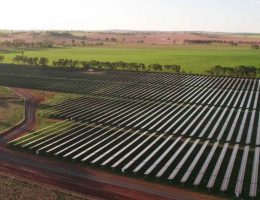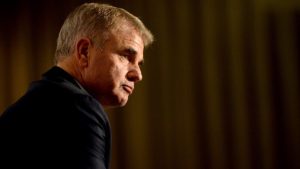New reports have emerged of major rift between federal energy minister Angus Taylor and the body tasked with developing a redesign of Australia’s National Electricity Market, with allegations that Energy Security Board chair Kerry Schott was pressured to resign over her refusal to fall in line with the Morrison government’s obsession with gas.
In a report on Monday night, ABC TV’s Four Corners program alleged that Taylor’s head of department called Schott and “urged her to resign” after she refused to support the minister’s repeated assertion that NSW coal plant closures would leave a generation gap big enough to require a new plant.
MICHAEL BRISSENDEN, REPORTER: Why did your head of department call Kerry Schott and suggest she resign?
ANGUS TAYLOR, FEDERAL ENERGY MINISTER: Well, he didn’t. I reject that, absolutely. But what I will say is that there was an independent review of the ESB that proposed and recommended the abolition of the ESB. Obviously, there was discussion about how best to respond to that recommendation. We’ve ultimately made the decision we want to support the ESB to completing the 2025 market design work. This is a crucial piece of work about the future of our electricity grid. And we strongly supported Kerry to lead that work.
The allegation was denied by Taylor on the program, but not by Schott, who said only that it was “a private discussion.”
Four Corners said it was also told that Taylor had personally intervened to pressure then head of the Australian Energy Market Operator, Audrey Zibelman, to change the forecasts included in its Integrated System Plan, which were unfavourable to gas. That request, too, was reportedly refused.
This was also denied by Taylor’s office, which in a written response to further questions from the ABC said undue pressure was not exerted on AEMO’s CEO and that the minister was only seeking an explanation of the operator’s gas price modelling.
The allegations are shocking, but perhaps not surprising. Taylor has made little mention of the ISP, a well-respected blueprint for the country’s energy transition over the next 20 years, apart from mocking it as “lines to nowhere”.
And, as RenewEconomy has reported, the Morrison government made a sport of threatening direct interventions in the energy market, including plans to build a new gas generator at Kurri Kurri, that could be as large as 1000MW in generation capacity, in response to the closure of the Liddell power station in NSW.
ANGUS TAYLOR, FEDERAL ENERGY MINISTER: We are saying that we will step up if the private sector doesn’t step in. We know from our own modeling, if there’s not a significant piece of capacity replacing the loss then there’ll be upward pressure on prices.
The fact that practically nothing and no one supports this move – not the energy industry itself, nor the NSW government, nor, as Schott points out below, the data from the Australian Energy Market Operator – has not deterred Taylor and his boss from pushing a gas-led Covid recovery for Australia.
KERRY SCHOTT: The operator AEMO who keeps a close watch on the availability and what they need in the system, has said that there’s a gap when Liddell goes in 2023 of about 200 megawatts or so.
MICHAEL BRISSENDEN:: Well, why does the federal government for instance, continue to stick to this thousand megawatt figure?
KERRY SCHOTT, CHAIR, ENERGY SECURITY BOARD: I don’t know, Michael, I’d ask them.
So he did.
MICHAEL BRISSENDEN: Why do you keep insisting it’s a thousand megawatts?
ANGUS TAYLOR: Because that’s reliability. There’s also affordability. Theres’ two things we have to worry about here with losing a major piece of capacity.
The allegations come at what RenewEconomy’s Michael Mazengarb last week described as a “do-or-die moment” for Australia’s energy transition, with the ESB’s proposed redesign of the NEM now in Taylor’s hands.
The ESB’s Market Design Options Paper, which outlines a detailed proposal following months of consultation, was delivered to federal energy minister Angus Taylor at the end of March – a first port of call before being possibly distributed to state and territory energy ministers for signing off before it is released publicly to seek stakeholder feedback.
As was reported last week, there is serious concern about the lack of transparency in this process and the creation of a new structure that leaves Taylor in apparent sole arbiter of the process, acting for a government which has been opposed to wind and solar and which has mocked new technologies such as big batteries.
One state government official contacted by RenewEconomy said he could not confirm if the state government had received the ESB documents, because of the requirements of the new “cabinet” process that has replaced the COAG energy ministers’ arrangements. “I can’t even confirm to you if today is Monday or Tuesday,” he said.
Taylor’s and the Morrison government’s insistence on a gas led recovery contrasts sharply with the views of the energy ministers in the Liberal governments in NSW and South Australia.
MATT KEAN, NSW ENERGY MINISTER: If you’re going to get to net zero emissions by 2050 then you need to be out of fossil fuels by the mid 2030s. So yes, we need gas now, but we need a plan to move away from gas. I’ll listen to the engineers and the experts. And that’s exactly how we design energy policy in New South Wales. New South Wales energy policy is determined by engineers, experts, and economists, not ideologues.
DAN VAN HOLST PELLEKAAN, SA ENERGY MINISTER: We’ll use less and less gas over the time. We have four grid-scale batteries operating at the moment in South Australia, we have two more already established to, started construction, and we’ll get more and more of those.










